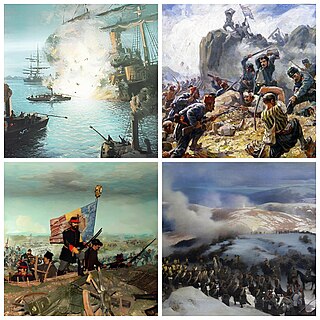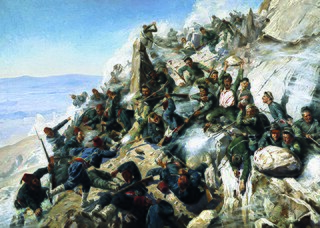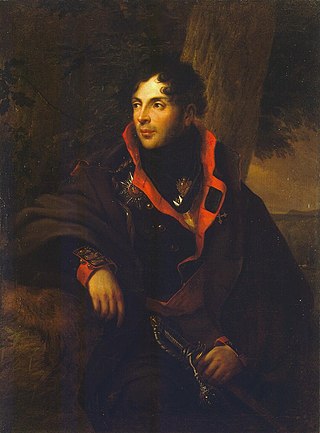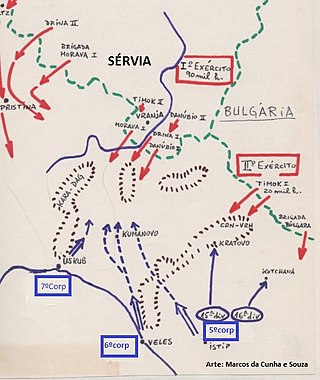
The Russo-Turkish War was a conflict between the Ottoman Empire and a coalition led by the Russian Empire which included Bulgaria, Romania, Serbia, and Montenegro. Fought in the Balkans and in the Caucasus, it originated in emerging 19th-century Balkan nationalism. Additional factors included the Russian goals of recovering territorial losses endured during the Crimean War of 1853–56, re-establishing itself in the Black Sea and supporting the political movement attempting to free Balkan nations from the Ottoman Empire.

The Russo-Turkish War of 1828–1829 was sparked by the Greek War of Independence of 1821–1829. War broke out after the Ottoman Sultan Mahmud II closed the Dardanelles to Russian ships and revoked the 1826 Akkerman Convention in retaliation for Russian participation in October 1827 in the Battle of Navarino.

The Russo-Turkish War (1806–1812) between the Russian Empire and the Ottoman Empire was one of the Russo-Turkish Wars. Russia prevailed, but both sides wanted peace as they feared Napoleon's moves to the east.

The Russo-Turkish War of 1676–1681, a war between the Tsardom of Russia and Ottoman Empire, caused by Turkish expansionism in the second half of the 17th century.

The Battle of Shipka Pass consisted of four battles that were fought between the Russian Empire, aided by Bulgarian volunteers known as opalchentsi, and the Ottoman Empire for control over the vital Shipka Pass during the Russo-Turkish War (1877–1878). The deciding moment of the Shipka campaign, and by extent the war, came in August 1877, when a group of 5,000 Bulgarian volunteers and 2,500 Russian troops repulsed an attack against the peak by a 30,000-strong Ottoman army.

The siege of Plevna or Pleven, was a major battle of the Russo-Turkish War of 1877–1878, fought by the joint army of Russian Empire and Kingdom of Romania against the Ottoman Empire. After the Russian army crossed the Danube at Svishtov, it began advancing towards the centre of modern Bulgaria, with the aim of crossing the Balkan Mountains to Constantinople, avoiding the fortified Turkish fortresses on the Black Sea coast. The Ottoman army led by Osman Pasha, returning from Serbia after a conflict with that country, was massed in the fortified city of Pleven, a city surrounded by numerous redoubts, located at an important road intersection.

The Battle of Petrovaradin also known as the Battle of Peterwardein, took place on 5 August 1716 during the Austro-Turkish War when the Ottoman army besieged the Habsburg-controlled fortress of Petrovaradin on the Military Frontier of the Habsburg monarchy. The Ottomans attempted to capture Petrovaradin, the so-called Gibraltar on the Danube, but experienced a great defeat by an army half the size of their own, similar to the defeat they had experienced in 1697 at Zenta. Ottoman Grand Vizier Damad Ali Pasha was fatally wounded, while the Ottoman army lost 20,000 men and 250 guns to the Habsburg army led by Field Marshal Prince Eugene of Savoy.

The Battle of Kagul or Cahul occurred on 1 August 1770 during the Russo-Turkish War of 1768–1774. It was the decisive and most important land battle of the war and one of the largest battles of the 18th century. It was fought in Moldavia, near the village of Frumoasa, nearly a month after the Russian victory at Larga.

Count Nikolay Mikhailovich Kamensky was a Russian general who outlived his father, Field Marshal Mikhail Kamensky, by two years.

The night attack at Târgoviște was a battle fought between forces of prince Vlad III of Wallachia, and sultan Mehmed II of the Ottoman Empire on Thursday, 17 June 1462. The battle started after Mehmed II, who already had tense relations with Vlad, discovered his alliance with Hungary's king Matthias Corvinus and ordered his forces to ambush him. Vlad foiled the attack and invaded Bulgaria. In response, Mehmed raised a great army with the objective to conquer Wallachia. The two leaders fought a series of skirmishes, the most notable one being the conflict where Vlad attacked the Turkish camp in the night in an attempt to kill Mehmed. The assassination attempt failed and Mehmed marched to the Wallachian capital of Târgoviște, where he found a few men with cannons. After leaving the capital, Mehmed discovered 23,844 impaled Turks whom Vlad had killed during his invasion of Bulgaria. The number is mentioned by Vlad himself in a letter to Matthias Corvinus. The sultan and his troops then sailed to Brăila and burned it to the ground before retreating to Adrianople. Mehmed's forces returned home with many captured slaves, horses, and cattle.

The Battle of Rymnik or Rimnik, also Battle of Mărtinești, on September 22 [O.S. September 11] 1789, took place in Wallachia, at the Râmnicul Sărat River near Râmnicu Sărat during the Russo-Turkish War of 1787–1792 and the Austro-Turkish War of 1788–1791. The Russian general Alexander Suvorov, acting together with the Habsburg general Prince Josias of Coburg, attacked the main Ottoman army under Grand Vizier Cenaze Hasan Pasha. The result was a crushing Russo-Austrian victory.
The Battle of Tashkessen or Battle of Tashkesan was a battle of the Russo-Turkish War of 1877–1878. It was fought between the Ottoman Empire and the Russian Empire on December 31, 1877, in what is now Bulgaria.

The Battle of Focșani was a battle in the Russo-Turkish War (1787–1792) fought on 1 August 1789 between the Ottoman Empire and the alliance of the Russian Empire and the Habsburg monarchy near Focșani, Moldavia. The Russians were led by Alexander Suvorov, the Austrians by Prince Josias of Coburg, and the Ottomans by Osman Pasha.

Count Sergei Mikhailovich Kamensky was a Russian infantry general who served in the Napoleonic wars.

The Battle of Kumanovo, on 23–24 October 1912, was a major battle of the First Balkan War. It was an important Serbian victory over the Ottoman army in the Kosovo Vilayet, shortly after the outbreak of the war. After this defeat, the Ottoman army abandoned the major part of the region, suffering heavy losses in manpower and in war materiel.

The Battle of Slobozia was fought between Russia and the Ottoman Empire as a part of the Napoleonic Wars during the Russo-Turkish War of 1806–1812. The primary battle occurred on the left bank of the Danube River near the small village of Slobozia in Wallachia. Four miles to the southeast on the right bank of the Danube was the Ottoman fortress at Rusçuk. The Russian investment of the Ottoman forces at Slobozia including the final battle lasted approximately two and half months from 28 August to 14 November 1811, ending when Russian Commander Mikhail Kutuzov ultimately accepted the surrender of the Ottoman forces commanded by Ahmed Pasha.
Cenaze Hasan Pasha was a short-term Ottoman grand vizier in 1789. His epithet Cenaze means "corpse" because he was ill when appointed to the post.
Emmanouil Papadopoulos was a Greek officer in Imperial Russian service. Born on the Ottoman island of Kea, Papadopoulos chose to depart with the Russian troops who had briefly occupied it when he was a teenager.

The Battle of Başgedikler occurred on 1 December 1853 during the Crimean War when a Russian army attacked and defeated a large Turkish force near the village of Başgedikler in the Trans-Caucasus.
The Battle of Obilești was fought in Obilești, Wallachia, between Russia and the Ottoman Empire as a part of the Napoleonic Wars during the Russo-Turkish War of 1806–1812.
















